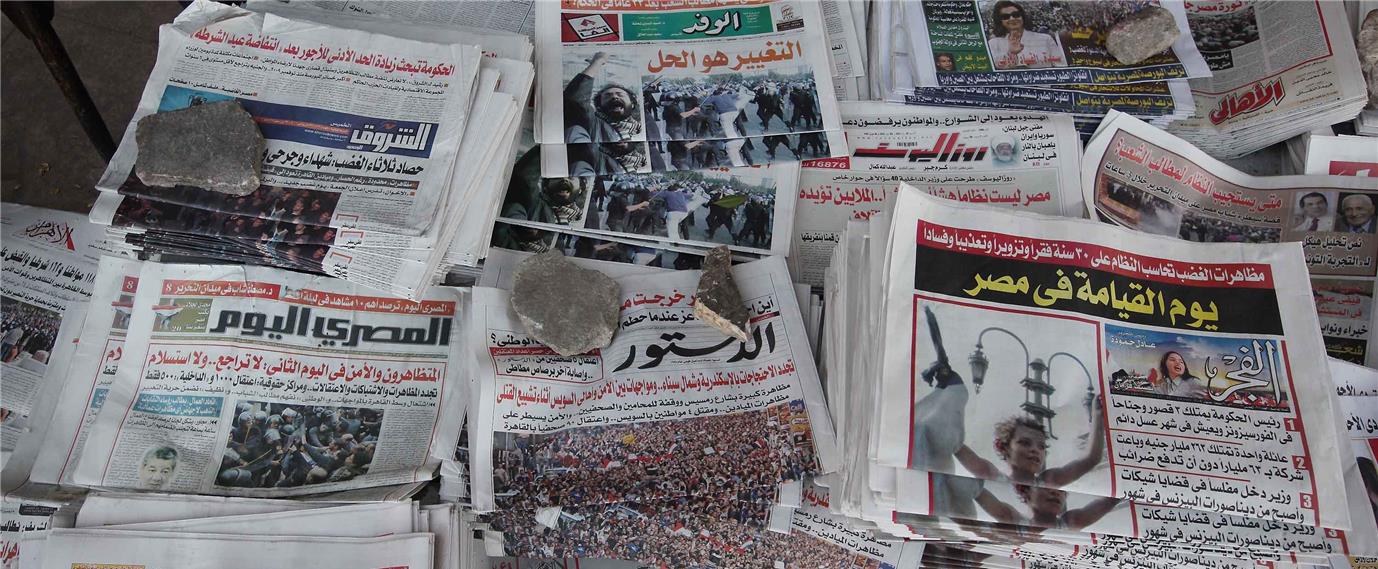|
المؤلف: عيد رحيل الناشر: المكتب العربي للمعارف- القاهرة عدد الصفحات: 438 الطبعة الأولى: 2016 |
يزداد موقف الصحافة المطبوعة تأزما مع التطور الكبير الذي يشهده الإعلام الرقمي، الذي يحظى بظروف إنتاج أفضل، سواء في تقدمه المتلاحق في إمكانيات بناء وعرض القصص الخبرية، أو في قدراته الإنتاجية والأدواتية التي يمكن امتلاكها والتعامل معها بيسر، لاسيما مع اتساع انتشاره بسبب سهولة التلقي عبر الهواتف المحمولة وأجهزة الحاسوب، والاعتماد المتسع على الإنترنت.
وفي هذا الكتاب، يحاول المؤلف الذي يعمل مدرسا مساعدا بقسم الصحافة في كلية الإعلام بجامعة القاهرة، إلى جوار عمله في الإخراج الصحفي، تحديد أسباب أزمة الصحف الورقية في مصر وسبل تجاوزها التي رأى أنها تندرج جميعا تحت عنوان واحد هو "الإبداع"، باعتباره الطريق الوحيد، ليس فقط للبقاء والاستمرار وإنما للمنافسة والتأثير.
ومن خلال مقدمة وثمانية فصول، يوضح المؤلف ما يعنيه بالإبداع في المنتج الصحفي، وشروط توفر المناخ الإبداعي، وكيفية تغيير الأساليب السائدة في المؤسسات الصحفية، والشروط الواجب توافرها في التفكير الإبداعي، وعلى رأسها القابلية للتنفيذ، وسبل الإبداع في الصحافة الخاصة، وتأثير السياقات الشخصية والمجتمعية على الإبداع في الإخراج الصحفي.
ويبني المؤلف رؤيته منطلقا من مفهوم محوري يرى أن الصحافة تنتمي إلى ما يطلق عليه "الصناعات الفكرية" التي تقدم منتجات تحمل كثيرا من السمات الجمالية، مُرجعا الموقف الذي تحياه الصحافة المطبوعة اليوم إلى أسباب عديدة، بعضها عام تعاني منه السوق الصحفية على مستوى العالم، وبعضها خاص بالسوق والمجتمع المصريين.
عقبات الهيكل التنظيمي
يرى المؤلف أن الإبداع الصحفي يواجه كثيرا من العقبات البنيوية الراسخة في الهياكل التنظيمية للصحف، فالعمل الصحفي يصدر نتاجا متضافرا لجهود وأفكار كثير من الأفراد والأقسام المختلفة للجريدة، التي يبدأ العمل لإصدار عددها الجديد من خلال اجتماع رؤساء أقسامها، وتحديد الموضوعات المطلوبة، ومناقشة اقتراحات المحررين الذين يشرعون في كتابة ما أقره الاجتماع التحريري في صورة أخبار أو تقارير أو تحقيقات وحوارات، تمر عبر عدد من الحواجز، من بينها رؤساء الأقسام، ثم غرفة التحرير المركزية (الديسك) التي تعيد صياغة هذه الموضوعات وفق السياسية التحريرية للجريدة.
وبانتهاء هذه المرحلة، نكون إزاء منتج نصي Verbal content))، يدخل في مرحلة تالية متمثلة في إنتاج المضمون البصري Visual content)) عبر تصميم الصفحات، حيث يلتقي النص المكتوب مع ما أنتجه قسم التصوير أو الرسوم، لتتم عملية الإخراج، ورسم الماكيت، وفق السياسة الإخراجية المتفق عليها.. وكل هذه المراحل تدل على جماعية المنتج الصحفي، حتى لو صدر في صورته النهائية منسوبا إلى اسم واحد فقط.
ويشير المؤلف إلى عقبة المساحة التي تعاني منها الإصدارات المطبوعة، فكل صحيفة تصدر في عدد معين من الصفحات يتسم غالبا بالثبات، ونادرا جدا ما يزيد، بسبب ارتفاع أسعار الورق وتكاليف الطباعة. وهذه المحدودية في المساحة تخلق صراعا دائما بين أطراف العمل الصحفي (المضمون، الشكل، الإعلان) للفوز بأكبر مساحة ممكنة.
وإضافة إلى هذه العقبات التنظيمية والهيكلية، يرى المؤلف أن عامل "الوقت" يمثل تحديا كبيرا أمام عملية الإبداع الصحفي، فمهلة إنتاج الصحيفة اليومية لا تتجاوز ساعات قلائل، والأخبار سلعة تعادي الوقت، والمستهلك يبحث دائما عن الجديد، مما يفرض على المحررين في كثير من الأحيان أن يكون إبداعهم لحظيا، وأن تكون أفكارهم التجديدية سريعة ومواكبة لغزارة تدفق المادة الصحفية.
الصحف الخاصة
خلال العقدين الماضيين عرفت مصر عددا من الصحف الخاصة التي استطاعت أن تدخل سوق المنافسة مع المؤسسات القومية الكبرى، واستحوذت على مساحات جماهيرية معتبرة، بعدما اجتذبت عددا من الكفاءات الصحفية العاملة بالمؤسسات المملوكة للدولة، كما استعانت بقوة بعناصر الشباب وحديثي التخرج الطامحين إلى إثبات قدراتهم في الإثراء والتجديد، مما جعل هذه الصحف الخاصة الميدان الأرحب للإبداع الصحفي.
وبرأي المؤلف، فإن الدافع الشخصي كان وقود العملية الإبداعية في الصحف الخاصة، فشباب الصحفيين تملؤهم الرغبة في تغيير وجه الصحافة المصرية، أو أن يضيفوا -على الأقل- معالجات جديدة في مسيرة المهنة، مما يمكنهم من حصد شهرة شخصية، وهو دافع كفيل بأن يعمل هؤلاء على تكسير قواعد الصحافة التقليدية، بل وتجاوزها بما يورطهم أحيانا مع قوى المجتمع المختلفة، سواء أكانت هذه القوى سياسية أم اجتماعية.
وتجلى إبداع الصحف الخاصة في السياسة الإخراجية الواضحة التي تحدد طرق معالجة قضاياها، والالتزام بقوالب في الشكل والألوان والخط وعدد كلمات العناوين، بما يكسب الصحيفة شخصية متميزة.. والتزمت معظم الصحف الخاصة بتصميم هندسي لاسمها، تمشيا مع الاتجاه العام في تصميم العلامات التجارية ومطاعم الوجبات السريعة وأسماء الشركات.
كما طورت هذه الصحف طرائق التعامل مع الصور، فابتعدت عن نشر الصور الرسمية والمصافحات التقليدية، مرجحة الصور ذات المضامين. كما أفردت بعض الصحف مساحات كبيرة للصورة تصل أحيانا إلى صفحة كاملة، وقدمت الصورة باعتبارها موضوعا مستقلا يصاحبه عنوان فقط، أو كلمات قليلة معبرة، وغالبا ما يتم ذلك في الصفحات الأخيرة كما هي الحال في صحف "المصري اليوم" و"الشروق" و"الدستور".
وبالإجمال، فقد حملت الصحف الخاصة على عاتقها مهمة ثقيلة، وهي أن تحجز لنفسها مكانا بين نمطين من الصحافة يضربان بجذورهما في أعماق السوق، وهما الصحف القومية والصحف الحزبية. كما تصدت هذه الصحف لمهمة تغيير إرث الأفكار والتفضيلات لدى القارئ، فكان لا بد لها من أن تظهر بشكل ومضمون غير معتادين، وكان الإبداع حاجة ملحة وضرورية للنجاح والاستمرار.
سياق الإبداع
ويخصص المؤلف عدة فصول من كتابه لمناقشة ما يسميه السياق الإبداعي، باعتبار أن السياق أهم العوامل الموضحة للمواقف والمشكلات، وخاصة في الخطابات والنصوص المفسرة والناقدة، حيث تستمد الكلمة أو الجملة معناها من خلال ما يحيط بها من كلمات وجمل أخرى، وما يتزامن معها من ظروف.. وصحفيا، يمكن اعتبار السياق مجموعة العناصر المحيطة بالنص المكتوب، مثل شخصية الكاتب والقارئ وتكوينهما الثقافي، والعوامل والظواهر الاجتماعية ذات العلاقة باللغة والسلوك والاعتقاد الديني.
وإضافة إلى العوامل الشخصية، يتوقف المؤلف أمام السياقات المؤسسية، أو الثقافة التي تهيمن على أعضاء مؤسسة صحفية بعينها، والتي قد تكون لها آثار مكبلة لإبداع الأفراد. ويمثل المؤلف لهذا الجانب بالعقبات التي تواجه محاولات الإبداع في الإخراج الصحفي، ومنها الإصرار على التعامل مع الصحيفة باعتبارها منتجا تجاريا يجب لفت الأنظار إليه بأي طريقة حتى لو كانت بعيدة عن الذوق الفني، وتكبيل المخرجين برؤى إدارية وبيرقراطية غير واعية.
وتمثل العلاقة بين إدارة التحرير وقسم الإخراج مفصلا محوريا في قدرة المخرجين الصحفيين على الإبداع، ومن ذلك طبيعة شخصية رئيس التحرير ومدى تدخله في عمل المخرج بالتعديل أو القبول أو الرفض، ومدى الالتزام بالمواعيد المحددة سلفا لرسم الصفحات بما يمنح المخرجين وقتا كافيا للإبداع والتجديد.. ويلفت المؤلف النظر إلى أن الموقف الذي يتخذه رئيس التحرير بالمخرجين غالبا ما ينعكس تلقائيا على كل أفراد إدارة التحرير في الجريدة.
كما يمثل "التحدي" أحد العوامل المهمة في توفير سياق إبداعي مُواتٍ، فالأفراد يميلون إلى الإبداع حين تسند إليهم مهام بها قدر من التحدي والتعقيد، إذ لا يفضل المبدعون المهام الروتينية التي يتم إنتاجها من خلال عمليات متعارف عليها مسبقا.
بيئة التلقي
ويرصد المؤلف السمات والتوجهات المجتمعية التي يمكن أن تؤثر بدرجة كبيرة في الشكل الذي تظهر به صفحات الجرائد، أو الأفكار الإبداعية التي يرغب المخرج الصحفي في تقديمها، فالثقافة السائدة تقرر ما يقبل وما يرفض، لا سيما إذا تعلق الأمر بالعادات والتقاليد أو بالدين، مع الأخذ بعين الاعتبار أنه لا قيمة جمالية لعمل لا يراه المتلقي المستهدف كذلك.
كما أن الأنشطة الثقافية والفنية بوجه عام تواجه مشكلة توصيل المنتج الإبداعي إلى مستهلكيه، فالنجاح الفني أو الاقتصادي مرتبط غالبا بعدد الأفراد المتلقين له، وتنبع تلك المشكلة عادة من حاجة تلك الأنشطة إلى الإعلان عن وجودها، ثم ما تتطلبه من جهد لتوزيعها وتوصيلها إلى المتلقين.
وبرأي المؤلف، فإن الظروف الاقتصادية تؤثر في العملية الإبداعية الصحفية، ولا سيما في مرحلة الإخراج، فضعف الإمكانيات المادية ينعكس على تجهيزات المؤسسات الصحفية، مثل اقتناء الأجهزة والبرامج الحديثة التي تساعد المخرج على التجديد والابتكار. كما أن الرغبة المستمرة لدى المؤسسات في تخفيض الإنفاق، تنعكس بالأساس على قسم الإخراج، فكثير من الصحف المصرية الخاصة لم تهتم بإيجاد بدائل المخرجين الذين أنهوا علاقتهم بالجريدة.







































